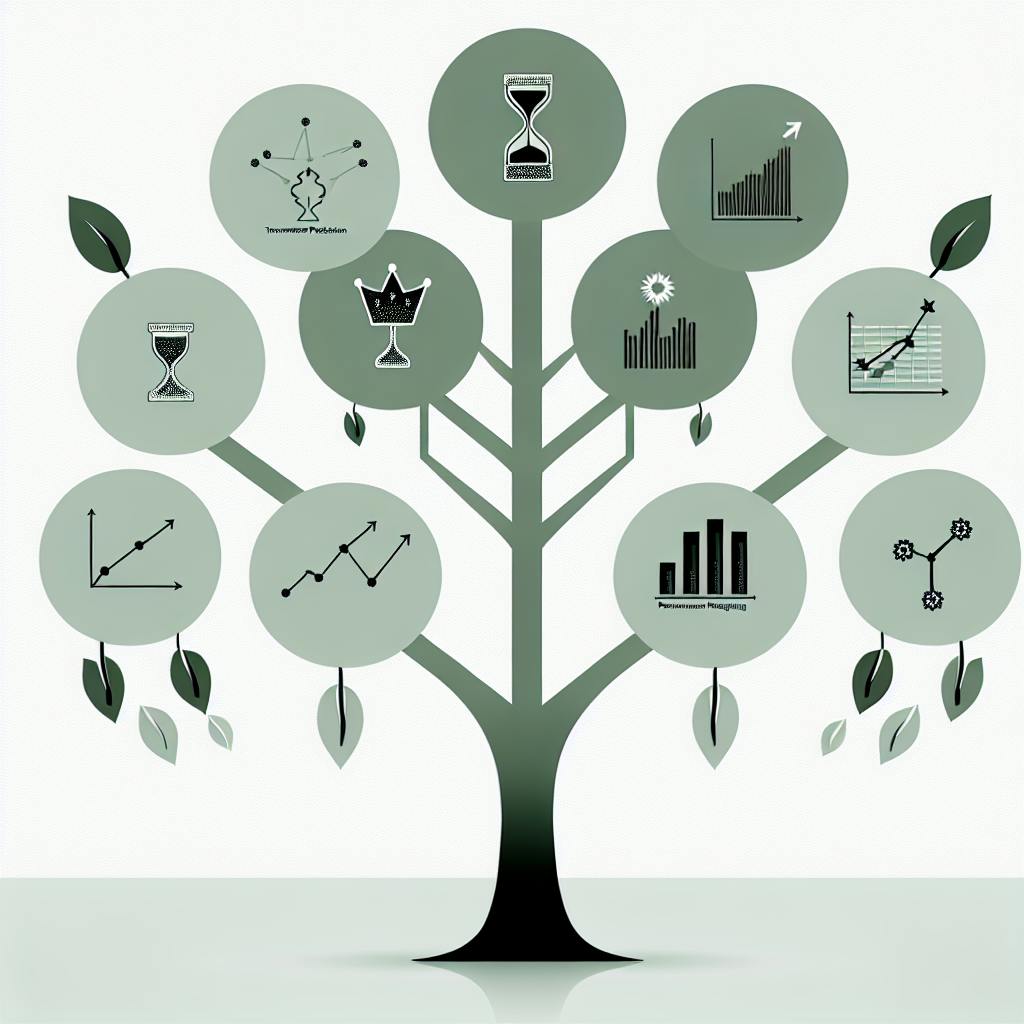Predictive analytics is a data-driven approach that uses historical data and statistical algorithms to predict future outcomes in talent acquisition. By analyzing large amounts of data, it identifies patterns and trends to predict the success of candidates for specific roles.
Benefits of Predictive Analytics in Hiring:
- Identify the most promising candidates
- Streamline the hiring process
- Improve the overall quality of hire
- Enhance hiring accuracy
- Save time and costs
- Reduce bias and promote diversity
- Improve employee retention rates
Key Concepts:
| Concept | Description |
|---|---|
| Data Management | Collecting, cleansing, transforming, and integrating high-quality data from various sources. |
| Predictive Modeling Techniques | Algorithms and statistical models like regression analysis, decision trees, and machine learning. |
| Analytics Tools | Selecting the right tools based on data integration, algorithmic capabilities, user interface, and scalability. |
Best Practices:
- Ensure data quality and compliance
- Avoid bias in predictive hiring
- Integrate predictive analytics into talent acquisition strategies
The Future of Predictive Analytics in Hiring:
- Rising trend in recruitment
- Improving hiring outcomes and reducing turnover
- Shaping the future of work by identifying emerging trends and skills gaps
Predictive analytics is transforming talent acquisition, enabling organizations to make informed hiring decisions, gain a competitive edge, and drive business success.
Predictive Analytics Basics for HR
Defining Predictive Analytics in Recruitment
Predictive analytics in recruitment is a technology that helps forecast future outcomes. It uses statistics and learns from existing data to predict events, such as identifying strong hires for open positions, making quicker and better offers to candidates, and providing a better candidate experience.
Benefits of Predictive Analytics for HR
Implementing predictive analytics in recruiting offers several advantages:
| Benefits | Description |
|---|---|
| Enhanced Hiring Accuracy | Predictive analytics provides a more accurate assessment of a candidate's fit for a specific job role, leading to better-informed hiring decisions and reducing the risk of mismatches. |
| Time and Cost Savings | By automating certain aspects of the recruitment process and utilizing data-driven insights, predictive analytics helps streamline the hiring process, saving time and resources. |
| Reduced Bias | Predictive analytics helps mitigate bias by objectively assessing candidate qualifications and potential, ensuring a more inclusive and diverse candidate pool. |
| Improved Retention Rates | By accurately predicting a candidate's potential for success and fit within the organization, predictive analytics can contribute to higher employee retention rates, enhancing job satisfaction, engagement, and long-term commitment. |
By understanding the basics of predictive analytics and its benefits, HR professionals can make informed decisions about how to leverage this technology to improve their recruitment strategies and drive business success.
Key Concepts in Predictive Analytics for Hiring
Predictive analytics in talent acquisition relies on several key concepts that HR professionals should understand to effectively leverage this technology. In this section, we'll break down the central concepts that underpin predictive analytics in HR, including data management, algorithmic modeling, and analytics tools.
Data Management for Predictive Analytics
Data management plays a critical role in predictive analytics, as it ensures that the data used to build predictive models is accurate, complete, and relevant. HR professionals should focus on collecting high-quality data from various sources, such as candidate resumes, performance metrics, and employee feedback. This data should be stored in a centralized database, ensuring consistency and compliance with data protection regulations.
Effective data management involves:
- Data cleansing: removing duplicates, correcting errors, and filling in missing values
- Data transformation: converting data into a format suitable for analysis
- Data integration: combining data from different sources into a single, unified view
Predictive Modeling Techniques Overview
Predictive modeling techniques are the algorithms and statistical models used to analyze data and make predictions. Common techniques used in predictive analytics include:
| Technique | Description |
|---|---|
| Regression Analysis | Analyzes the relationship between variables to predict continuous outcomes |
| Decision Trees | Uses a tree-like model to classify candidates based on their characteristics |
| Machine Learning | Uses algorithms to learn from data and improve predictive accuracy over time |
HR professionals should understand the strengths and limitations of each technique to choose the most appropriate one for their specific use case.
Choosing Analytics Tools for Hiring
With numerous analytics tools available, HR professionals should consider several factors when selecting a tool for their organization. Key considerations include:
| Factor | Description |
|---|---|
| Data Integration | Can the tool integrate with existing HR systems and data sources? |
| Algorithmic Capabilities | Does the tool offer a range of predictive modeling techniques? |
| User Interface | Is the tool user-friendly and accessible to non-technical users? |
| Scalability | Can the tool handle large volumes of data and adapt to changing business needs? |
By understanding these key concepts, HR professionals can make informed decisions about how to leverage predictive analytics to improve their recruitment strategies and drive business success.
Predictive Analytics in Recruitment: Case Studies
Predictive analytics has transformed the recruitment process, enabling HR professionals to make data-driven decisions and improve hiring outcomes. In this section, we'll explore real-world examples and case studies demonstrating the power of predictive analytics in recruitment.
Improving Candidate Sourcing
Predictive analytics can significantly enhance candidate sourcing by identifying the most promising sources of talent and predicting the success rate of candidates. For instance:
| Company | Solution | Result |
|---|---|---|
| Koru | "Impact Skills" provides a candidate fit score | Reduced time-to-hire and improved quality of hires |
| Entelo | "More Likely to Move" algorithm identifies passive candidates | Improved chances of making a successful hire |
Optimizing Recruitment Workflows
Predictive analytics can also be used to identify bottlenecks and inefficiencies in the recruitment pipeline. By analyzing data on candidate flow, recruiters can optimize their workflows and reduce time-to-hire. For example:
- Identifying effective channels: Predictive analytics helps recruiters focus on the most promising sources of candidates.
- Improving candidate experience: Predictive analytics identifies areas where recruiters can improve the candidate experience, reducing dropout rates and improving overall hiring outcomes.
Predictive Models for Employee Retention
Predictive models can also be used to forecast employee turnover, allowing companies to develop proactive retention strategies. By analyzing data on employee behavior and performance, predictive models can identify patterns that indicate a higher risk of turnover. For example:
- Identifying at-risk employees: Predictive analytics helps companies identify employees who are at risk of leaving due to lack of opportunities for growth and development.
- Developing targeted retention strategies: Companies can develop targeted training programs to address these needs and reduce the risk of turnover.
These case studies demonstrate the power of predictive analytics in recruitment, from improving candidate sourcing to optimizing recruitment workflows and predicting employee retention. By leveraging predictive analytics, HR professionals can make data-driven decisions and drive business success.
sbb-itb-d78b90b
Best Practices for Using Predictive Analytics in Hiring
Predictive analytics is a powerful tool in the hiring process, but it requires careful consideration and implementation to ensure its effectiveness and fairness. In this section, we'll explore best practices for using predictive analytics in hiring.
Data Quality and Compliance
High-quality data is essential for effective predictive analytics. HR professionals must ensure that their data is:
| Data Quality Aspect | Description |
|---|---|
| Accurate | Verify the accuracy of data sources and ensure that they are free from errors and inconsistencies. |
| Complete | Ensure that all necessary data is collected and available for analysis. |
| Compliant | Ensure that data is stored and processed in accordance with relevant regulations, such as GDPR and CCPA. |
Avoiding Bias in Predictive Hiring
Predictive analytics can perpetuate biases if not implemented carefully. To avoid bias, HR professionals should:
- Use diverse data sources to minimize the risk of bias.
- Monitor predictive models for signs of bias and take corrective action.
- Utilize tools and techniques to detect bias in predictive models.
Integrating Predictive Analytics in Talent Acquisition
Integrating predictive analytics into talent acquisition strategies requires a step-by-step approach:
1. Define goals and objectives: Clearly define the goals and objectives of predictive analytics in hiring.
2. Choose the right tools: Select predictive analytics tools that align with organizational goals and objectives.
3. Develop a data strategy: Develop a data strategy that ensures high-quality data and compliance with regulations.
4. Monitor and evaluate: Continuously monitor and evaluate the effectiveness of predictive analytics in hiring.
By following these best practices, HR professionals can ensure that predictive analytics is used effectively and fairly in the hiring process, leading to better hiring outcomes and improved business success.
The Future of Predictive Analytics in Hiring
Predictive analytics is transforming the way organizations approach talent acquisition. By integrating this technology into their hiring strategies, organizations can gain a competitive edge in the war for talent.
The Rise of Predictive Analytics in Recruitment
According to LinkedIn's Global Recruiting Trends, 56% of professionals say that new interview tools are the top trend impacting how they hire. Predictive analytics is at the heart of many of these tools, enabling smarter, more efficient hiring processes.
Improving Hiring Outcomes
As technology advances and data becomes increasingly available, predictive analytics will continue to improve in accuracy and sophistication. This will enable organizations to make even more informed hiring decisions, reducing turnover and improving overall business performance.
Shaping the Future of Work
Predictive analytics will play a critical role in shaping the future of work. As the job market continues to evolve, predictive analytics will help organizations identify emerging trends and skills gaps, enabling them to stay ahead of the curve and adapt to changing requirements.
Key Takeaways
| Key Takeaway | Description |
|---|---|
| Predictive analytics is transforming talent acquisition | Enables organizations to gain a competitive edge in the war for talent |
| Improving hiring outcomes | Reduces turnover and improves overall business performance |
| Shaping the future of work | Helps organizations identify emerging trends and skills gaps |
In conclusion, the future of predictive analytics in hiring is promising, and its potential to transform the way organizations approach talent acquisition is vast. By embracing this technology, HR professionals can unlock new insights, improve hiring outcomes, and drive business success.
FAQs
What is predictive modeling in HR analytics?
Predictive modeling in HR analytics uses statistics and machine learning to make informed decisions about recruiting, staffing, and other HR functions. It analyzes data from CVs and HRIS systems to improve talent management.
How does predictive analytics enhance talent acquisition?
Predictive analytics enhances talent acquisition by identifying patterns and trends that can help predict the success of candidates in specific job roles. This enables recruiters to make informed hiring decisions, reducing the risk of bad hires and improving overall business performance.
What are some common challenges of using predictive analytics in recruitment?
| Challenge | Description |
|---|---|
| Data Quality | Incomplete or biased data can lead to inaccurate predictions. |
| Privacy | Ensuring data privacy and compliance with regulations is essential. |
| Ethical Considerations | Predictive analytics must be used fairly and without bias. |
By understanding these challenges, recruiters can ensure that predictive analytics is used effectively and fairly in the hiring process.


